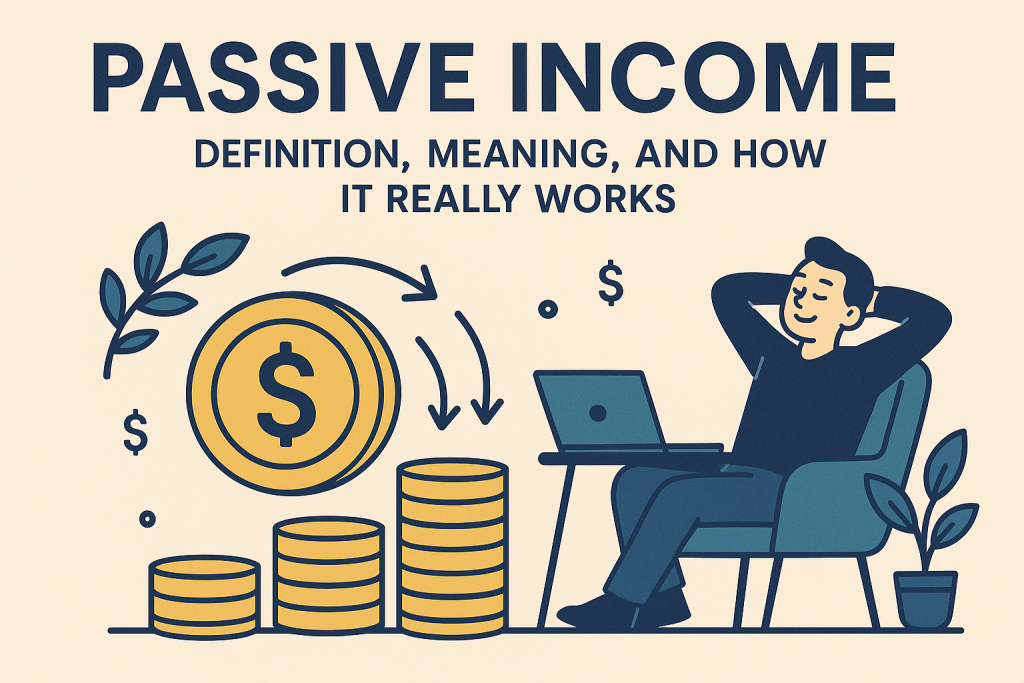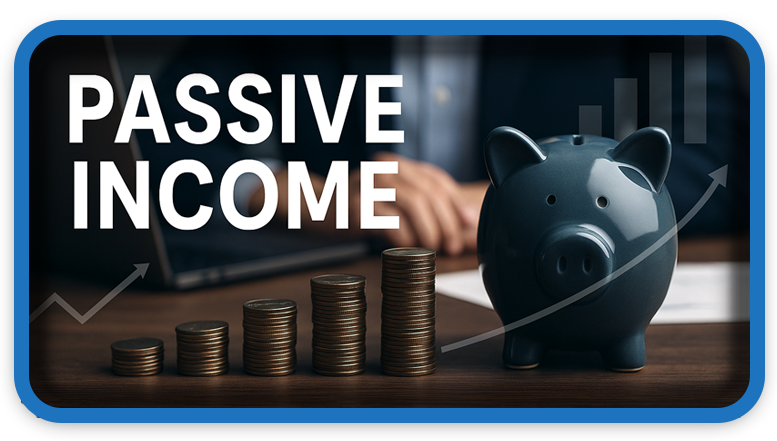⏲️ Estimated reading time: 8 min
Passive Income: Definition, Meaning, and How It Really Works. Passive income is more than just “making money while you sleep.” This in-depth guide defines passive income, explains how it works, its advantages and risks, and explores real-world examples to help you build financial independence.
The concept of passive income has captured the imagination of entrepreneurs, investors, and everyday individuals looking to achieve greater freedom in life. The dream of making money while you sleep is one of the most powerful ideas in modern finance, but what does it actually mean?
Many people misunderstand passive income as “easy money.” In reality, it involves an upfront investment of time, effort, or money to build systems that generate revenue with minimal day-to-day involvement. From rental properties to dividend-paying stocks, online businesses, and royalties, passive income takes many forms.
This article provides a comprehensive definition of passive income, breaks down how it works, compares it with active income, and examines its pros, cons, and practical strategies to help you decide whether it fits into your financial journey.
1. The Core Definition of Passive Income
At its simplest, passive income refers to money earned with little or no direct daily effort. Unlike wages or salaries where you trade time for money passive income flows in after the initial work or investment is completed.
Key Elements of Passive Income
- Initial Input Required: You usually need to invest either time, money, or both to create a source of passive income.
- Ongoing Maintenance: While the phrase suggests zero work, most forms of passive income require at least some management. For example, landlords still deal with tenants, and investors must monitor portfolios.
- Scalability: Once the system is built, passive income often allows for scaling without proportional effort. An e-book, for example, can be sold to 10 people or 10,000 with little difference in workload.
2. Passive Income vs. Active Income
To fully understand the definition, it’s important to contrast passive and active income.
- Active Income: Money earned through direct involvement, such as a salary, freelance project, or hourly wage. You stop working you stop earning.
- Passive Income: Money generated with minimal active involvement. The effort is front-loaded, but the cash flow continues after the initial setup.
Example:
- A graphic designer who creates logos for clients earns active income.
- The same designer who sells a course on logo design and earns royalties every month generates passive income.
3. The Two Main Types of Passive Income
Passive income can be divided into two categories: investment-based and asset-creation-based.
A. Investment-Based Passive Income
This form requires capital upfront. You invest money into assets that produce regular returns with little involvement.
Examples include:
- Dividends from stocks
- Interest from bonds or savings accounts
- Real estate rentals
- Peer-to-peer lending
B. Asset-Creation-Based Passive Income
Here, the investment is primarily time and creativity rather than money. Once created, the asset keeps earning revenue.
Examples include:
- Writing a book and collecting royalties
- Developing a mobile app
- Creating a YouTube channel with ad revenue
- Selling online courses or digital products
Both approaches can be powerful, and many successful entrepreneurs combine them for diversified streams.

4. Common Misconceptions About Passive Income
Because it is often marketed as a “get-rich-quick” solution, passive income is misunderstood. Let’s clear up some myths.
Myth 1: Passive income requires no work.
Reality: Most passive income streams require heavy upfront work whether it’s writing, coding, investing, or building.
Myth 2: Passive income is instant.
Reality: It can take months or years before your efforts pay off. A rental property must be purchased and managed, an online course must attract buyers, and investments require patience.
Myth 3: Passive income is risk-free.
Reality: All forms of income carry risks property markets crash, businesses fail, and royalties can dry up if demand disappears.
5. Real-World Examples of Passive Income
To bring the definition to life, here are some detailed examples:
1. Rental Properties
- You buy a property and rent it out. The rent provides monthly income, but you may need to deal with repairs, tenants, and property taxes.
- Some investors hire property managers to make it more “hands-off.”
2. Dividend Stocks
- Buying shares of companies that pay regular dividends (like Coca-Cola or Johnson & Johnson) provides quarterly or annual income.
- It’s considered one of the most stable forms of passive income but requires capital.
3. Digital Products
- Creating and selling e-books, courses, stock photos, or software can produce recurring income.
- Once built, these products can be sold repeatedly with minimal extra effort.
4. Royalties
- Musicians, authors, and inventors often earn royalties every time their work is purchased, streamed, or licensed.
5. Affiliate Marketing
- Running a blog, YouTube channel, or website that promotes products with affiliate links can create long-term income streams.
6. Automated Online Businesses
- Dropshipping or print-on-demand stores allow people to sell goods without managing inventory or shipping.

6. Advantages of Passive Income
Why is passive income so desirable?
- Financial Freedom: It reduces dependence on one job or paycheck.
- Time Flexibility: Once established, it allows you to earn money without constant work.
- Scalability: Unlike a salary, passive income streams can grow exponentially.
- Diversification: Multiple income sources reduce financial risk.
- Potential for Early Retirement: Many people use passive income to reach financial independence faster.
7. Risks and Challenges of Passive Income
While appealing, passive income has drawbacks:
- High Upfront Investment: Either in money (real estate) or time (writing a book).
- Delayed Gratification: Success is rarely immediate it may take years.
- Market Risks: Economic downturns, changing trends, and competition can reduce income.
- Maintenance Required: “Hands-off” doesn’t mean “zero effort.” Updating courses, fixing rental properties, or adjusting investments are ongoing tasks.
8. Passive Income and Financial Independence
Passive income is closely tied to the concept of financial independence the point where your income covers your expenses without requiring active work.
- Example: If your monthly expenses are $3,000, and your rental properties plus dividends bring $3,500 per month, you are financially independent.
- This allows you to choose whether to work, retire early, or pursue passion projects.
9. Building Your First Passive Income Stream
For beginners, the idea of starting passive income may feel overwhelming. Here’s a step-by-step framework:
- Assess Resources: Do you have more time or more money? Choose accordingly.
- Pick a Stream: Rental properties if you have capital, blogging or online courses if you have skills.
- Start Small: Build one stream before expanding.
- Reinvest Profits: Use early earnings to fund additional streams.
- Automate and Outsource: Use tools or hire people to reduce workload.
10. Passive Income in the Digital Age
Technology has revolutionized passive income opportunities. Platforms like YouTube, Amazon Kindle, Shopify, and Udemy allow individuals to reach a global audience. Similarly, investing apps make stock dividends accessible to beginners with small budgets.
In many ways, digital assets are becoming the modern foundation of passive income, because they scale faster and require less capital compared to traditional investments.
11. The Psychological Side of Passive Income
Beyond the numbers, passive income changes your relationship with work and money.
- It encourages a long-term mindset rather than instant gratification.
- It teaches patience and resilience, since results often come slowly.
- It provides a sense of security knowing your earnings are not tied to one job.
12. Case Studies of Passive Income Success
Case 1: The Self-Publishing Author
Jane writes an e-book in her spare time, invests 3 months in creating it, and uploads it to Amazon Kindle. Within a year, it earns $500 per month, and by the third year, multiple books bring her $3,000 monthly.
Case 2: The Investor
Michael invests $100,000 in dividend-paying stocks. His portfolio generates $4,000 annually, and he reinvests dividends. Over 15 years, this grows into a strong retirement income stream.
Case 3: The YouTuber
Sarah starts a YouTube channel reviewing gadgets. After 2 years of consistent uploads, she earns ad revenue plus affiliate income. By year 4, she makes more from her channel than her full-time job.
13. The Future of Passive Income
As technology evolves, AI, blockchain, and automation will create new forms of passive income. For example:
- Decentralized finance (DeFi) offers interest on crypto assets.
- AI tools help create automated content, courses, and apps.
- Subscription models and creator platforms expand earning potential.
Final Thoughts
The definition of passive income is straightforward: income that continues to flow with little day-to-day effort after the initial investment of time, money, or creativity. However, the journey to building it is often anything but simple.
It requires planning, patience, and persistence. But for those who commit, passive income can transform not only your finances but also your lifestyle, providing the freedom to live on your terms.
🔔 For more tutorials like this, consider subscribing to our blog.
📩 Do you have questions or suggestions? Leave a comment or contact us!
🏷️ Tags: passive income, definition of passive income, financial independence, active vs passive income, investing, side hustles, online business, rental income, dividend stocks, royalties
📢 Hashtags: #PassiveIncome, #FinancialFreedom, #Investing, #MoneyTips, #WealthBuilding, #SideHustle, #DigitalBusiness, #OnlineIncome, #DividendStocks, #RentalProperties
Only logged-in users can submit reports.
Discover more from HelpZone
Subscribe to get the latest posts sent to your email.

